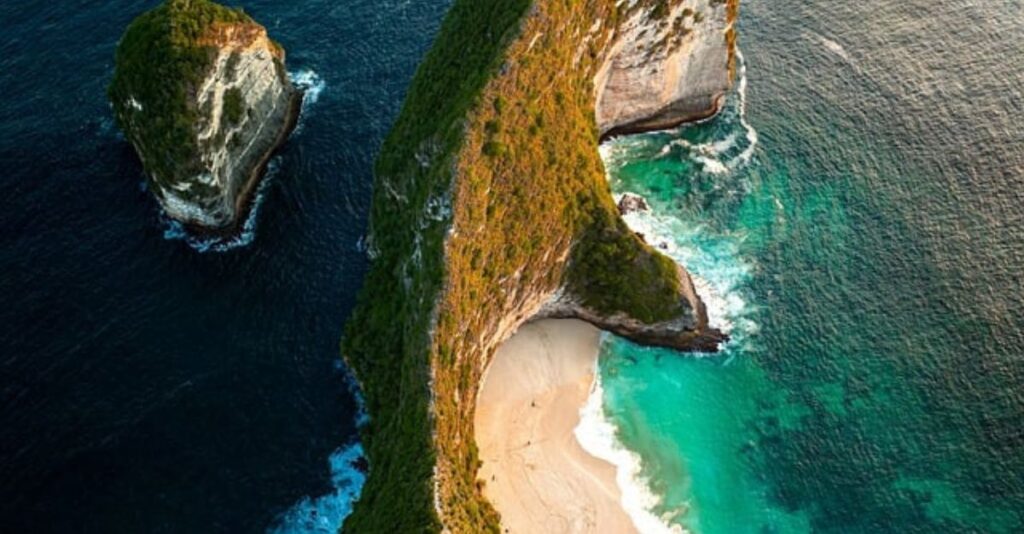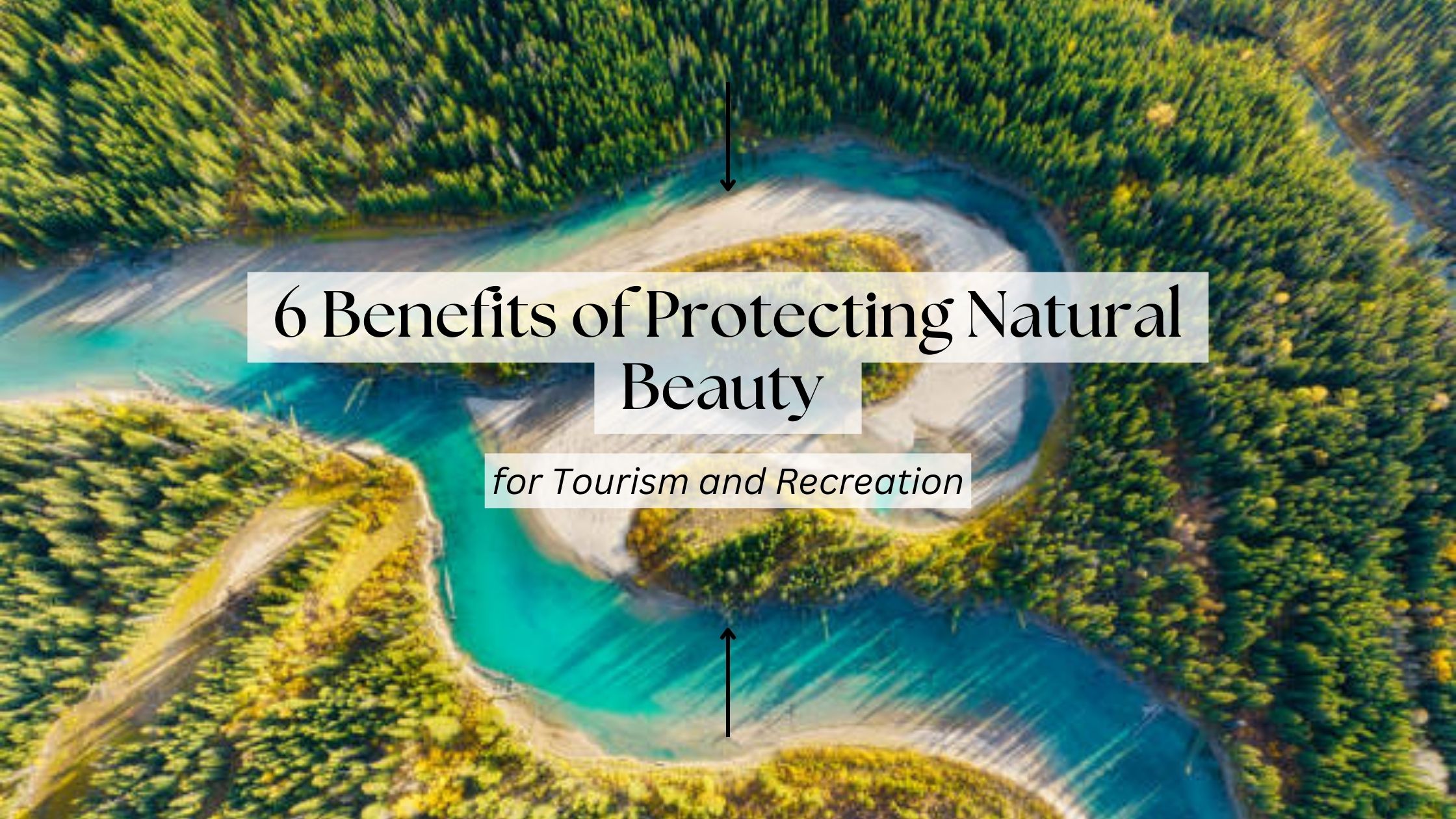Introduction
6 Benefits of Protecting Natural Beauty for Tourism and Recreation
Preserving natural beauty isn’t just an environmental necessity—it’s a key driver for sustainable tourism and recreation. By safeguarding forests, beaches, mountains, and other natural landscapes, we ensure that future generations can enjoy these wonders while boosting local economies. Here are six significant benefits of protecting natural beauty for tourism and recreation:
6 Benefits of Protecting Natural Beauty for Tourism and Recreation

1. Attracts Sustainable Tourism
Natural beauty is a magnet for travelers seeking authentic experiences. Destinations with well-preserved landscapes attract eco-conscious tourists, creating a demand for sustainable tourism. This reduces environmental impact while generating income for local communities.
For example, pristine beaches and lush forests draw nature lovers, photographers, and adventurers who are willing to pay for eco-friendly accommodations and guided tours.
2. Supports Local Economies
Conservation initiatives often lead to increased tourism revenue. Visitors spend money on lodging, food, transportation, and activities, boosting local businesses. Moreover, eco-tourism jobs—such as tour guides, park rangers, and conservationists—provide stable employment for residents.
Protected natural areas also encourage investment in infrastructure, such as roads and visitor centers, further stimulating economic growth.
3. Enhances Recreational Opportunities
Preserved natural spaces provide countless recreational activities, such as hiking, swimming, kayaking, birdwatching, and camping. These activities improve physical and mental well-being for locals and visitors alike while promoting a deeper appreciation for the environment.
Accessible and well-maintained parks and reserves also encourage outdoor activities, making them a vital resource for community health and leisure.
4. Preserves Biodiversity
Protecting natural beauty ensures the survival of diverse plant and animal species. Rich biodiversity enhances the appeal of tourist destinations, offering unique opportunities for wildlife viewing and nature exploration.
Conservation efforts, such as reforestation and marine habitat protection, not only support ecosystems but also create attractions that educate and inspire visitors about the importance of environmental stewardship.
5. Mitigates Climate Change
Forests, wetlands, and oceans act as natural carbon sinks, absorbing greenhouse gases and regulating the climate. By protecting these environments, we combat climate change, which poses a significant threat to tourism-dependent regions.
Healthy ecosystems also reduce the risk of natural disasters like floods and droughts, ensuring that tourist destinations remain safe and enjoyable.
6. Builds Long-Term Resilience
Conservation builds resilience against environmental degradation and over-tourism. When natural beauty is preserved, destinations avoid the pitfalls of environmental exhaustion, ensuring they remain attractive and viable for future generations.
Educating tourists and locals about sustainable practices fosters a culture of care and responsibility, ensuring that natural wonders continue to thrive.
Tips for Protecting Natural Beauty
Protecting our natural beauty is essential for maintaining a healthy environment. Here are some tips to help preserve the world’s natural wonders:

- Reduce, Reuse, Recycle: Minimize waste by following the three R’s. Properly dispose of recyclables and reduce single-use plastics.
- Conserve Water: Use water wisely. Fix leaks, install water-saving fixtures, and avoid wasting water.
- Plant Trees: Trees help combat climate change and provide habitats for wildlife. Participate in tree-planting activities.
- Use Sustainable Products: Choose eco-friendly products made from renewable resources. Avoid products with excessive packaging.
- Support Conservation Organizations: Donate to or volunteer with organizations dedicated to protecting the environment.
- Educate Others: Spread awareness about the importance of conservation and encourage others to adopt eco-friendly practices.
- Reduce Energy Consumption: Use energy-efficient appliances, switch to LED bulbs, and unplug electronics when not in use.
- Respect Wildlife: Observe animals from a distance and avoid disturbing their natural habitats.
- Participate in Cleanups: Join local or global initiatives to clean up beaches, parks, and other natural areas.
- Support Sustainable Tourism: When traveling, choose eco-friendly accommodations and activities that have minimal impact on the environment.
By incorporating these practices into your daily life, you can make a significant impact in preserving the beauty of our natural world. 🌿🌍
Suggestions for Policymakers
Policymakers play a crucial role in protecting and preserving natural beauty. Here are some suggestions to help them make effective decisions:
- Enact and Enforce Environmental Laws: Create and strictly enforce laws that protect natural resources, wildlife, and habitats. Implement penalties for violations to ensure compliance.
- Promote Sustainable Practices: Encourage sustainable agriculture, forestry, and fishing practices. Support the development and use of renewable energy sources.
- Support Conservation Efforts: Allocate funding for conservation programs and projects. Work with conservation organizations to protect endangered species and critical habitats.
- Develop Green Infrastructure: Invest in green infrastructure, such as parks, green roofs, and urban forests, to enhance urban environments and provide natural spaces for communities.
- Educate the Public: Implement educational campaigns to raise awareness about the importance of environmental protection. Promote eco-friendly practices among citizens and businesses.
- Incentivize Eco-Friendly Initiatives: Provide financial incentives, such as tax breaks or grants, for businesses and individuals who adopt environmentally friendly practices.
- Strengthen Climate Policies: Develop and implement policies to reduce greenhouse gas emissions and mitigate the impacts of climate change. Support international agreements and collaborations.
- Protect Water Resources: Implement policies to protect and manage water resources, including rivers, lakes, and aquifers. Promote water conservation and pollution prevention.
- Promote Sustainable Tourism: Encourage tourism practices that minimize environmental impact and support the preservation of natural and cultural heritage sites.
- Foster Collaboration: Work with local, regional, and international partners to address environmental challenges. Share best practices and collaborate on solutions.
By adopting these strategies, policymakers can help safeguard the natural beauty of our world for future generations.
Benefits Recap
That’s a fantastic list of benefits! To summarize:

- Attracts Sustainable Tourism and Boosts Local Economies: Encouraging eco-friendly tourism can generate revenue for local communities.
- Creates Job Opportunities: Eco-tourism and conservation efforts can provide employment in sectors like wildlife preservation, park management, and eco-tourism services.
- Provides Recreational Opportunities: Access to natural spaces promotes physical health and mental well-being through activities like hiking, bird-watching, and nature trails.
- Supports Biodiversity: Conserving natural areas helps maintain ecosystems and species diversity, which is essential for the planet’s health.
- Mitigates Climate Change Impacts: Protecting natural landscapes can enhance resilience against natural disasters like floods and wildfires, while also reducing carbon emissions.
- Builds a Sustainable Future: Integrating sustainable practices ensures that tourism and local communities can thrive in the long term without depleting natural resources.
These benefits emphasize the importance of conservation efforts not only for environmental health but also for economic and social well-being. 🌿🌍
Conclusion
Protecting natural beauty is not only vital for the environment but also a cornerstone for sustainable tourism and recreation. From economic benefits to climate resilience, conservation initiatives create a win-win scenario for people and the planet. By prioritizing these efforts, we ensure that the breathtaking landscapes we enjoy today will continue to inspire and support future generations.
References
- International Union for Conservation of Nature (IUCN) – www.iucn.org
- United Nations Environment Programme (UNEP) – www.unep.org
- World Tourism Organization (UNWTO) – www.unwto.org
- Leave No Trace Center for Outdoor Ethics – www.lnt.org
- International Ecotourism Society – www.ecotourism.org
FAQs
Q: How does conservation benefit tourism?
A: Conservation ensures that natural landscapes remain intact and attractive, drawing tourists who value pristine environments and wildlife experiences.
Q: What is sustainable tourism?
A: Sustainable tourism minimizes environmental impact, supports local economies, and promotes cultural and environmental preservation.
Q: How can individuals contribute to protecting natural beauty?
A: Individuals can adopt eco-friendly travel habits, support conservation initiatives, and educate others about the importance of sustainability.
Q: Why is biodiversity important for tourism?
A: Biodiversity enhances the uniqueness of a destination, offering diverse attractions like wildlife viewing, which are key draws for eco-tourists.
Q: What role do governments play in conservation?
A: Governments create policies, allocate funds, and establish protected areas to ensure the preservation of natural landscapes and biodiversity.

